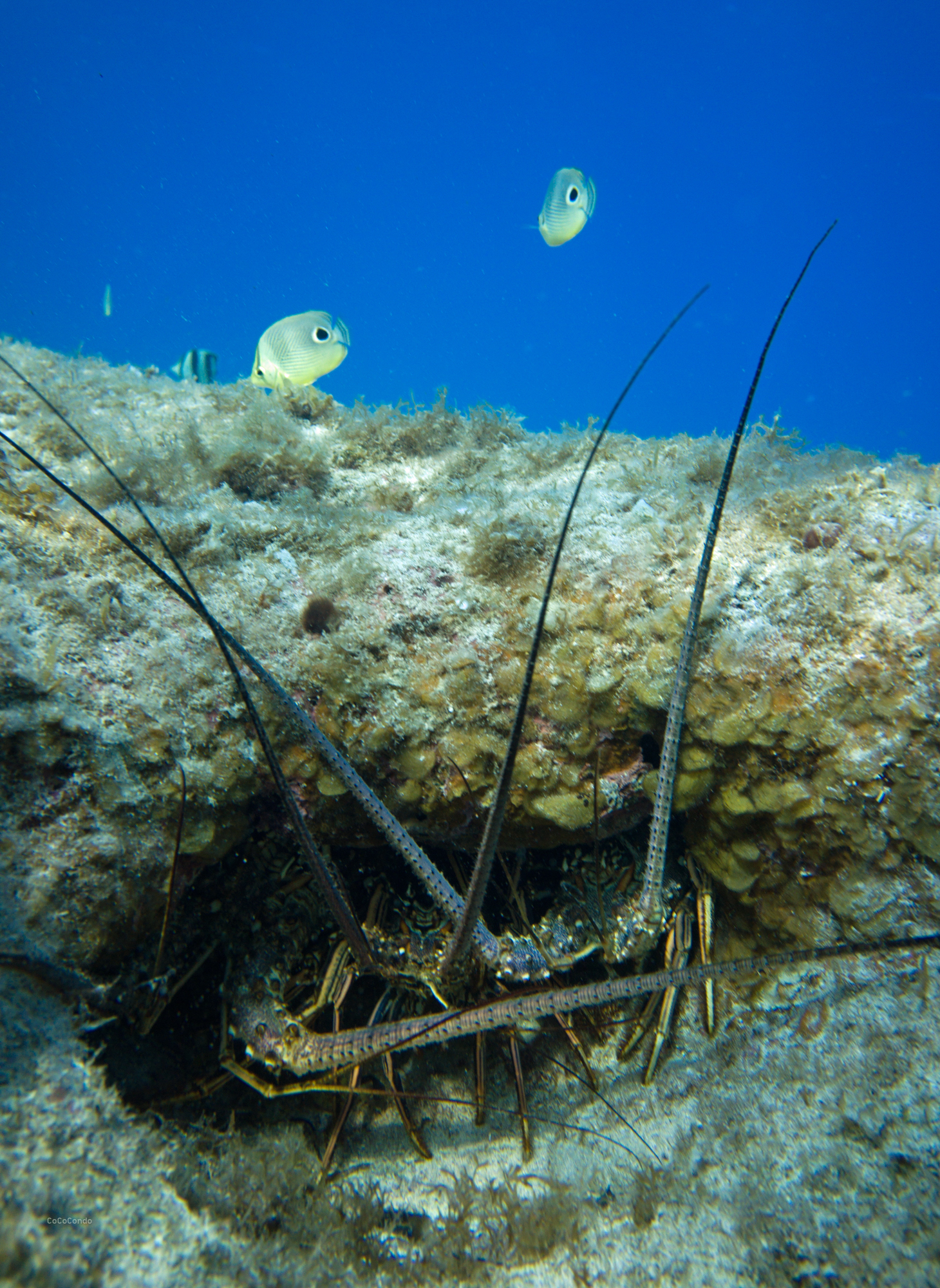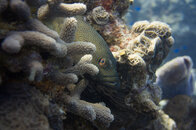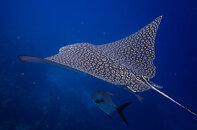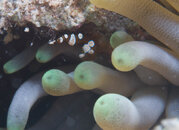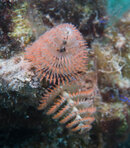Alucard
Contributor
I have a really amazing partner!
During our recent trip to Grand Cayman I got presented with a DC2000 as a birthday present.
I got the chance to do one dive with it, before other commitments and weather got in the way, but I thought I would share.
I had previously been doing underwater photography with an old FujiFilm and had got a bit frustrated at the results - my camera for my extended surface intervals is a Nikon D90 and I have always been pleased with what it can do, but didn't want to spend the money on an underwater housing for it. Apart from the optics, I love the idea that it shoots in RAW mode, and allows me to edit the photo in Photoshop Elements without any loss of data. My old FujiFilm only shot JPG and it was quite compressed.
So the first thing I did with the DC2000 was changed it to "RAW+JPG" mode, then started playing with the underwater filters that are built-in.
I didn't realise that it had essentially no storage out of the box, so had to go and spend top dollar for a memory card. Oh well.
The housing I find difficult to get open - the benefit is probably that it won't fly open while underwater! The instructions say never to use any silica gel or O-ring lubricant on it, which feels odd to me, because I always used to clean that. It also says to replace the O-ring once a year. I guess I will have to order some spares....
So I had a lanyard for my BCD that I could clip on - I could have it short or on a spiral line. Figured I would use that still, and it worked very well. The camera seemed slightly positively buoyant. This dive was with just the camera with no external lights or extra lenses.
The dive site was Hepp's Pipeline - a shore dive from the Coconut Bay condo complex in West Bay, Grand Cayman. The objective was drop down fairly quickly, and just hang out on top of the mini wall where the light is good, as I didn't have my external flash with me. So much for a dive plan, as it turned out....
Always that nervous moment when you first descend - is the camera flooding? Nope! Swimming towards the wall over the mostly barren floor. Oh there is a hole in the ground and something sticking out of it... I unclip my camera from the short lanyard and hold it on the ground in portrait mode, hoping....
As usual, you never have a clue how these things will turn out until you get back to a computer, right?
Next, the edge of the wall..
another one of those shots where you really have no idea how it will look.
Went down to the bottom of the wall (70 feet) and took a video of a Stingray. I was quite pleased with how that came out - haven't had the chance to edit it yet and have run out of space on here to post it. I really liked how the video button was just one push, and the still photo button was just one push. Less messing around with buttons and more time focusing on what I was trying to capture in my camera!
In the sand at the bottom there was a blenny. I figured that would be a good test because the autofocus on my old camera couldn't even see it to focus. I got two or three decent shots before it dove into its hole and they were all sharp and in focus! Another win!
Then, off in the distance a turtle! I swim to slightly beneath and to its side and start another video. At various times I hit the photo button to do the photo while taking the video..
Then I come back up on top of the wall and take a few more videos and stills...
(sorry I can't upload them all here - these are shrunk down by a LONG way to deal with the storage limits here).
Transferring to my computer was easy - simple USB cable. The various underwater filter settings are only applied to the JPG version, not the RAW version (which I suppose shouldn't have surprised me).
So, from this very limited experience, here is what I see...
Pros
During our recent trip to Grand Cayman I got presented with a DC2000 as a birthday present.
I got the chance to do one dive with it, before other commitments and weather got in the way, but I thought I would share.
I had previously been doing underwater photography with an old FujiFilm and had got a bit frustrated at the results - my camera for my extended surface intervals is a Nikon D90 and I have always been pleased with what it can do, but didn't want to spend the money on an underwater housing for it. Apart from the optics, I love the idea that it shoots in RAW mode, and allows me to edit the photo in Photoshop Elements without any loss of data. My old FujiFilm only shot JPG and it was quite compressed.
So the first thing I did with the DC2000 was changed it to "RAW+JPG" mode, then started playing with the underwater filters that are built-in.
I didn't realise that it had essentially no storage out of the box, so had to go and spend top dollar for a memory card. Oh well.
The housing I find difficult to get open - the benefit is probably that it won't fly open while underwater! The instructions say never to use any silica gel or O-ring lubricant on it, which feels odd to me, because I always used to clean that. It also says to replace the O-ring once a year. I guess I will have to order some spares....
So I had a lanyard for my BCD that I could clip on - I could have it short or on a spiral line. Figured I would use that still, and it worked very well. The camera seemed slightly positively buoyant. This dive was with just the camera with no external lights or extra lenses.
The dive site was Hepp's Pipeline - a shore dive from the Coconut Bay condo complex in West Bay, Grand Cayman. The objective was drop down fairly quickly, and just hang out on top of the mini wall where the light is good, as I didn't have my external flash with me. So much for a dive plan, as it turned out....
Always that nervous moment when you first descend - is the camera flooding? Nope! Swimming towards the wall over the mostly barren floor. Oh there is a hole in the ground and something sticking out of it... I unclip my camera from the short lanyard and hold it on the ground in portrait mode, hoping....
Hepps Pipeline
3 Lobsters having a party with some Spotfin Butterfyfish providing the backdrop.
As usual, you never have a clue how these things will turn out until you get back to a computer, right?
Next, the edge of the wall..
Went down to the bottom of the wall (70 feet) and took a video of a Stingray. I was quite pleased with how that came out - haven't had the chance to edit it yet and have run out of space on here to post it. I really liked how the video button was just one push, and the still photo button was just one push. Less messing around with buttons and more time focusing on what I was trying to capture in my camera!
In the sand at the bottom there was a blenny. I figured that would be a good test because the autofocus on my old camera couldn't even see it to focus. I got two or three decent shots before it dove into its hole and they were all sharp and in focus! Another win!
Then, off in the distance a turtle! I swim to slightly beneath and to its side and start another video. At various times I hit the photo button to do the photo while taking the video..
Then I come back up on top of the wall and take a few more videos and stills...
On the mini wall
Always love to see plenty of fish on the reef. Taken at the Hepp's Pipeline dive site.
(sorry I can't upload them all here - these are shrunk down by a LONG way to deal with the storage limits here).
Transferring to my computer was easy - simple USB cable. The various underwater filter settings are only applied to the JPG version, not the RAW version (which I suppose shouldn't have surprised me).
So, from this very limited experience, here is what I see...
Pros
- Nice and compact - I don't feel like someone has to hand me down this massive rig and I can dive without having to hold it the whole time.
- Very good resolution, colours, and clarity
- Shoots RAW
- Screen is nice and bright and clear underwater at the regular screen brightness, even through the housing
- Buttons on the underwater housing are nice and big and easy to find
- Separate video and still buttons means you can switch between them very easily
- The ability to take still photos while making a video is great
- Video quality is really nice.
- Very good focus on more challenging subjects
- When in RAW mode, it takes a few seconds to store each picture. Can be frustrating when you want to do more shots quickly.
- The on-board flash is pretty weak (weaker than on my old cheap camera) - I am going to need to use my external light.
- I turned on the stabilise option for the video and got some of the GoPro style drunk feeling to the video. In future I will try turning that off and stabilising while editing.




